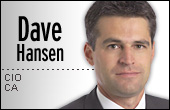Keeping CA's engine running

 |
Hansen, who assumed the hot seat in September 2006, told ZDNet Asia in an e-mail interview that the role of a CIO has evolved from earlier days as a "support-function oriented" role to more of a "business-enablement" role.
With over 18 years of experience in heading IT departments, Hansen said today's CIOs are moving up the value chain and taking on business process design and re-engineering responsibilities.
Hansen joined CA in 2002 and has held a number of appointments in the company, including senior vice president of CA Technology Services for North America in 2003, as well as senior vice president for worldwide presales in 2005.
Now back in his comfort zone of running an IT organization, Hansen is looking forward to helping CA run a tip-top technology business.
In an e-mail interview with ZDNet Asia, Hansen explains why he thinks CA is in a strong position with a portfolio that "is the best CA has ever had". He also talks about his role as a CIO in a global company and how he intends to address the talent crunch.
Name |
Q: You were in-charged of CA's global technology services department before becoming CIO. Which role do you find more interesting?
Hansen: I was previously responsible for our global presales or technical sales support [in the] organization, and before that, I ran the services team in North America. This was challenging and exciting. Prior to joining CA, I was always on the customer side of the desk. Taking on the CIO's role is really in my comfort zone. Five years working directly with our customers have provided me with an excellent foundation to reinvent the role of the CIO. An important part of my job is to be a showcase for CA's solutions. I know what our customers are looking for.
What do you think are the requirements of a CIO for a global IT company?
The skills that are essential to a CIO include a strong understanding of IT, good financial stewardship, cross-cultural awareness in a global environment, and understanding how IT aligns with the company's business objectives.
Do you think the global nature of your current capacity adds another dimension to the role?
I like to share data and knowledge with my CIO peers, and it's always beneficial to hear what different CIOs are doing with their organizational structures. Also, learning about their differing pressures, demands and approaches help keep me up to speed with customer CIO issues. [In addition], exposure to other CIOs, for example, helps me to run a leading-edge disaster recovery operation.
The CIO is becoming more important, and naturally his/her responsibility increases accordingly. How do you feel about that?
This is a status that has to be earned by CIOs. Many CIOs expect to be involved in making business decisions. In earlier days, the CIO's role was very much support-function oriented, but then [it] evolved rapidly to more of a business-enablement role. Now I see CIOs moving up the value chain and taking on business process design and re-engineering responsibilities.
What are your top five priorities in managing enterprise IT?
My current priorities are:
1. A successful SAP rollout--this is a critical implementation for CA because replacing applications and driving new and improved business processes will help CA in our ongoing transformation and make our IT organization more relevant to the business we run around the world.
2. Realizing the EITM (Enterprise IT Management) vision--this is our vision for enterprise IT management, which we are applying to CA's global operations. As we achieve greater integration, we are also quick to deploy the technology internally across our IT infrastructure. In fact, we expect to have made significant progress towards this goal by April 2007 when we will be holding our CA World event.
3. Employee development--the IT market is heating up fast, which means the supply of talent with the right experience and skills shrinks every day. This means we have to do more to ensure we have the right employees, and we need to invest seriously in skills development. This is key to our strategy.
4. Consolidation--this is about vendors, servers, services, networks and overall IT.
5. Continue to build a best-in-class IT organization--this includes all of the above.
On the subject of recruitment, please outline the issues, as you see them today, for maintaining and retaining a workforce of sufficient proficiency, especially in terms of training.
It is critical for me as CIO to be able to recruit the brightest talent and gather the most advanced skill-sets around the world. Obviously, the technology is now advanced, robust and reliable, so it's very much a matter of finding smart people who are well-trained enough to get the best out of our IT solutions.
In my 560-strong GIS (Global Information Services) organization, we have designed a clear training development plan and have categorized everyone according to 12 roles. I make sure our people achieve industry certification in each of the 12 categories they fall into. About 75 percent of our GIS team members already hold ITIL (IT Infrastructure Library) certification, with many others holding CISSP (Certified Internet Systems Security Professional) accreditation.
Do you think that IT people today are any different from 15 years ago?
I think it is important to fully understand IT people and what makes them tick. For example, they are not necessarily motivated just by money--but they do thrive on access to the latest technology. They want the very best they can get in training and skills, so that they can be proud of their capabilities.
CA truly understands IT people and the kind of values and priorities they hold. That's why we will be spending about US$1 million a year on the training program I mentioned. As well as producing very clear standards of accreditation, the results will include greater career satisfaction for the GIS workforce and enhanced skill-sets that will ultimately benefit customers.
Describe CA's IT environment. Do you feel it meets the requirements of a leading global IT company, and how do you plan to improve CA's IT environment?
My organization comprises enterprise infrastructure services, business solutions and compliance security. Our IT hubs are Islandia in New York State and Chicago in the United States, London, Hyderabad in India and Sydney in Australia. The following statistics help to give an idea of the scale of our organization:
- 40,000+ network devices;
- 1,300+ production servers running Linux, Unix and Windows;
- Four IBM mainframes, [with] 20+ LPARs (logical partitions), [and capable of computing] 15K MIPS (million instructions per second);
- 1,500+ voice and data circuits worldwide;
- 150+ phone systems;
- 300+ routers and 465+ switches;
- 500+ TB of array storage;
- [Customized] and packaged applications.
[In addition], we have just started [the third year] of a large-scale SAP implementation, which is aggressive, as we are replacing older applications. Having said that, a few "extended" applications will interface with our SAP core, [and] these are a combination of internal applications and remotely-hosted services.
As a global company, CA must cope with a variety of regulations around the world. How does CA manage these various IT resources and satisfy differing regulations?
We run a matrix IT organization to provide dedicated support within individual geographies, but which also remains aligned with the organization's overarching IT disciplines. For example, I have staff in Korea that report to the international IT team, but take overall functional direction from our head office in the United States. This ensures that both local and international standards are followed and that our overall environment cannot be compromised.
GIS people on the ground are trained in regional regulations that often differ around the world. Most importantly, my staff is distributed around the world in such a way [so] as to make sure we are close to our internal clients. After all, CA has some 15,000 employees globally.
Do you think CA should be focusing on other parts of the IT management spectrum? In other words, does your portfolio have any gaps, in your opinion as CIO?
We are in all the right spaces, as far as our products are concerned. Our portfolio is very mature in some areas, with room for improvement in others. CA believes in the philosophy of continuous improvement. The last two years have seen CA making some very tactical acquisitions to fill gaps in our portfolio. Frankly, today's CA portfolio is the best CA has ever had--we are in better shape than ever before to achieve our EITM vision to unify and simplify IT management for MNCs (multinational corporations) and enterprises alike.